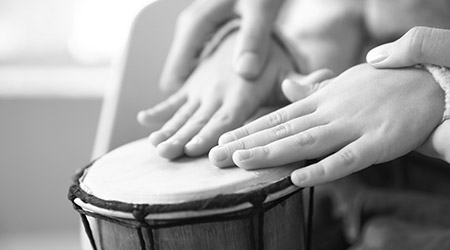
Activity #1 – Move to the Beat
It also emphasizes learning to follow directions, starting and stopping at an appropriate signal, and improving auditory processing.
Materials:
Drum or drum substitute (e.g: upside-down bowl or cooking pot)
Before Playing:
- Find an open, familiar space in which child can safely move about.
- Clear the area of any obstacles
How to Play:
- Have the child stand in the open space.
- Give the direction to walk when the drum says “walk” and stop when the drum says “stop.”
- Play a simple beat on a drum and have the child walk until the drumbeat stops.
- Observe the child’s normal walking pace to determine the appropriate tempo. Provide enough space to avoid bumping.
- Child can take turns being the drummer.
Variations:
- Add verbal directions to walk and stop at first but withdraw them as soon as possible so that the drum provides all auditory cues.
- Use fast taps as the cue for running.
- A tap on the rim provides a different sound, which can be a cue to walk backwards.
Activity 2 – Echo Playing
Music is an excellent tool for teaching children to follow directions and work on listening skills. Additionally, this activity works to improve auditory processing, short-term memory, and a sense of rhythm.
Materials:
One or two drums or drum substitutes (e.g: upside-down bowl or cooking pot)
How to Play:
- Child and parent each have drums or share one drum.
- The direction is given to listen and then do the same drumming pattern.
- Play a four-beat rhythm pattern, such as “One, two, buckle my shoe” and have the child repeat that pattern.
- Play another pattern and have the child repeat it.
- Let the child take turns playing patterns for the parent to repeat.
Variations:
- Use other instruments, such as rhythm sticks or wood blocks.
- Vary dynamics. The child can do the same or opposite dynamic. (e.g: “If I play loudly, you play softly.”)
- For more advanced students, extend the rhythm pattern beyond four beats.
- Hints: Adding words that fit the rhythm pattern (“One, two, buckle my shoe”) can help students who have a weaker sense of rhythm. Also, waiting and listening before playing is more difficult than playing a steady beat or rhythm pattern with the parent. Echo playing can be preceded by echo singing, or hand-over-hand assistance can be used.